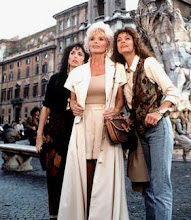 |
| Count Orlock's shadow in Nosferatu. |
Nosferatu (1922) - F.W. Murnau's silent vampire classic still chills today thanks to the director's haunting visuals and Max Schreck's memorable Count Orlok. It's the first horror screen classic, an unauthorized adaptation of Bram Stoker's Dracula.
 |
| Peter Cushing as Van Helsing. |
Abbott & Costello Meet Frankenstein (1948) - Take a laugh break with this funny, well-made send-up of Universal's 1930s and 1940s monster movies. The best scenes are the ones between Lou Costello's buffoon and Bela Lugosi's Dracula, who wants to transplant the former's brain into the Frankenstein Monster. Who thought Bela could play such a perfect straight man?
The Last Man on Earth (1964) - Writer Richard Matheson didn't care for this Italian-made adaptation of his popular novel I Am Legend, in which a plague of vampirism wipes out most of the Earth's population. I think it's an inventive, effective fright fest with a strong Vincent Price performance. Despite its budget limitations, it's superior to the semi-remake The Omega Man (1971) and the disappointing I Am Legend (2007).
The Night Stalker (1972) - Cynical newspaper reporter Carl Kolchak (Darren McGavin) discovers that a vampire is roaming the streets of contemporary Las Vegas--but no one will believe him. This made-for-TV movie became the highest rated television for many years. It spawned a pretty good 1973 sequel The Night Strangler and the short-lived Kolchak: The Night Stalker TV series.
The Fearless Vampire Killers (1967) - Roman Polanski's parody of vampire films is so good that it stands on its own as a first-rate horror picture. Polanski displays an uncanny understanding of the genre, from the snowy setting to the famous dance of the vampires (the film's original title). Sharon Tate exudes charm as the heroine, proving she was more than just a pretty face.
The Lost Boys (1987) - A divorced mother and her two teenage sons relocate to Santa Carla, California, to live with her father. The older son's sudden interest in a mysterious girl leads to his involvement with a gang of teen vampires. It's stylish and fun, if a bit lightweight. You may choose to substitute one of two other above-average 1980s teen vampire pictures: the more serious Near Dark (1987) or the more lighthearted Fright Night (1985), which features a delightful performance by Roddy McDowall as a Peter Cushing-like TV horror host.
 |
| Ralphie Glick at the window. |




















